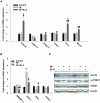Exendin-4 improves steatohepatitis by increasing Sirt1 expression in high-fat diet-induced obese C57BL/6J mice
- PMID: 22363635
- PMCID: PMC3281956
- DOI: 10.1371/journal.pone.0031394
Exendin-4 improves steatohepatitis by increasing Sirt1 expression in high-fat diet-induced obese C57BL/6J mice
Abstract
The effects of exendin-4 on Sirt1 expression as a mechanism of reducing fatty liver have not been previously reported. Therefore, we investigated whether the beneficial effects of exendin-4 treatment on fatty liver are mediated via Sirt1 in high-fat (HF) diet-induced obese C57BL/6J mice and related cell culture models. Exendin-4 treatment decreased body weight, serum free fatty acid (FA), and triglyceride levels in HF-induced obese C57BL/6J mice. Histological analysis showed that exendin-4 reversed HF-induced hepatic accumulation of lipids and inflammation. Exendin-4 treatment increased mRNA and protein expression of Sirt1 and its downstream factor, AMPK, in vivo and also induced genes associated with FA oxidation and glucose metabolism. In addition, a significant increase in the hepatic expression of Lkb1 and Nampt mRNA was observed in exendin-4-treated groups. We also observed increased expression of phospho-Foxo1 and GLUT2, which are involved in hepatic glucose metabolism. In HepG2 and Huh7 cells, mRNA and protein expressions of GLP-1R were increased by exendin-4 treatment in a dose-dependent manner. Exendin-4 enhanced protein expression of Sirt1 and phospho-AMPKα in HepG2 cells treated with 0.4 mM palmitic acid. We also found that Sirt1 was an upstream regulator of AMPK in hepatocytes. A novel finding of this study was the observation that expression of GLP-1R is proportional to exendin-4 concentration and exendin-4 could attenuate fatty liver through activation of Sirt1.
Conflict of interest statement
Figures






References
-
- Bellentani S, Saccoccio G, Masutti F, Crocè LS, Brandi G, et al. Prevalence of and risk factors for hepatic steatosis in Northern Italy. Ann Intern Med. 2000;132:112–117. - PubMed
-
- Tiikkainen M, Bergholm R, Vehkavaara S, Rissanen A, Häkkinen AM, et al. Effects of identical weight loss on body composition and features of insulin resistance in obese women with high and low liver fat content. Diabetes. 2003;52:701–707. - PubMed
-
- Donahey JC, van Dijk G, Woods SC, Seeley RJ. Intraventricular GLP-1 reduces short- but not long-term food intake or body weight in lean and obese rats. Brain Res. 1998;779:75–83. - PubMed
-
- Gutzwiller JP, Drewe J, Göke B, Schmidt H, Rohrer B, et al. Glucagon-like peptide-1 promotes satiety and reduces food intake in patients with diabetes mellitus type 2. Am J Physiol. 1999;276:R1541–1544. - PubMed
-
- Ahrén B, Schmitz O. GLP-1 receptor agonists and DPP-4 inhibitors in the treatment of type 2 diabetes. Horm Metab Res. 2004;36:867–876. - PubMed
Publication types
MeSH terms
Substances
LinkOut - more resources
Full Text Sources
Other Literature Sources
Research Materials
Miscellaneous

